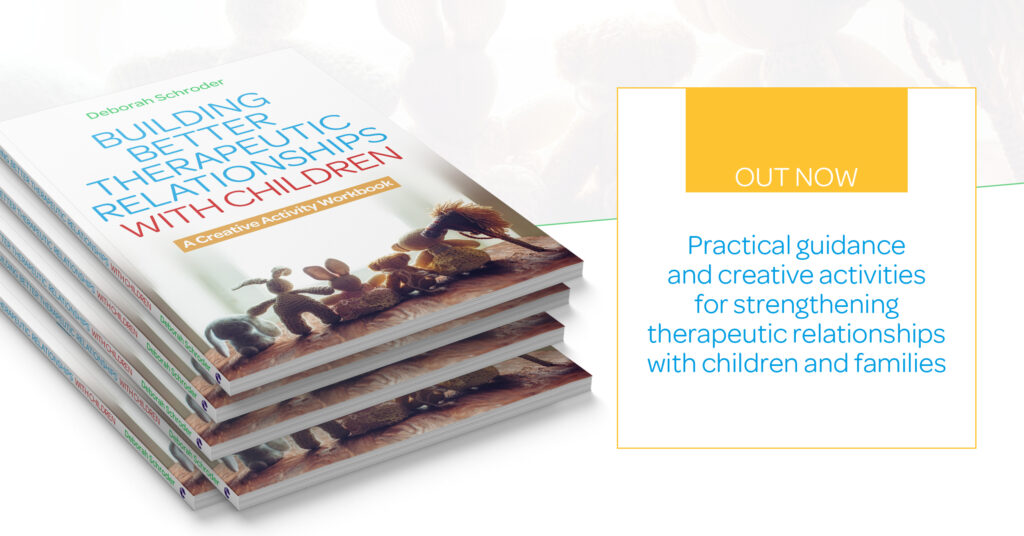This blog post was written by JKP author of Building Better Therapeutic Relationships with Children, Deborah Schroder.

The voice on the phone sounded familiar, and when she said her name I remembered her as a graduate I had in class a number of years ago. We caught up with each other a little and then she explained why she was calling: “I recently took a new job and just found out that they need me to see several child clients! I love doing therapy but I never planned on seeing children! Can you help me?”
My former student instinctively knew that children weren’t just miniature adults. She knew she needed some guidance before she tried to create therapeutic relationships with them. I remembered her internship client work and knew that she was a responsible, caring therapist with adults. And I’ve known plenty of good therapists who tried to talk their way through an intake with a child, only to find themselves hearing “I don’t know” or not getting an answer at all.
I wrote Building Better Therapeutic Relationships with Children because of so many graduates, students and colleagues who reached out to me with very similar children-related concerns.
I know that my own graduate school coursework couldn’t have prepared me to work with children because there just wasn’t room in the list of required courses for electives or special areas of interest. Through trial and error, research, and listening to more experienced therapists, I was able to develop my own therapeutic style with children, and it changed and grew as the places where I worked with children grew, including inpatient, day treatment, community arts center, agency family work, and outpatient private practice.
And of course I have my own tales of less-than-ideal sessions with children. I remember letting a boy paint his face and arms green much to the disappointment of his mom; I remember getting a small group of children so excited pretending to swim around the room as ocean creatures that they literally couldn’t calm down; and accidentally leaving the art supply cabinet open and waiting for a young boy to organize it before he was able to do therapy. And one therapeutic relationship seemed to depend on me playing Whitney Houston as bribery.
And so I wrote this book from a humble place!
But all in all, over the years, I did really enjoy working with kids. There is this place of hope when one sees children in therapy. We’ve all probably worked with adults who needed to spend much time working through issues that stemmed from difficult childhood experiences. It felt like a gift to work with children and parents to get past difficult family or school times. There was hope that as the child’s life moved forward things might be happier or healthier.
I have always asked students and colleagues whether or not they like children. I feel that’s the essential issue when working with children. And so I ask some questions in the book about one’s own experience and memories from childhood. There are a number of worksheets within the book to help therapists kind of puzzle-through their beliefs and feelings about childhood. I think that remembering our own childhoods helps us show up in a clearer way with our young clients.
Another important feature of this workbook is the variety of therapists I asked to be part of it. I interviewed therapists who have worked in a variety of settings with a lot of different kinds of child clients. Their ideas and words bring important information to this workbook. And these therapists and clinicians aren’t all cis-gender, heterosexual, white women. At least in the United States, we still have much work to do to diversify the mental health field. I think it helps to acknowledge the variety of voices holding wisdom as we move forward.
And I invite anyone who reads and uses this workbook to PLAY. Kick a ball, blow some bubbles, remember what was fun. It still can be. I’m just as bad at playing board games as I used to be, but I laugh a lot when I play with my grandchildren, and love the reconnection with FUN. Many of us had experiences in childhood that were scary or traumatic. Having fun doesn’t make those memories go away, but even as an adult, it reminds me that joyful moments from childhood can be remembered and incorporated into the therapists we’ve become. My Lamb-Chop puppet is perched beside my laptop as I write this, and as seriously as I take my therapy work, she won’t let me take myself too seriously.
Building Better Therapeutic Relationships with Children is available here!